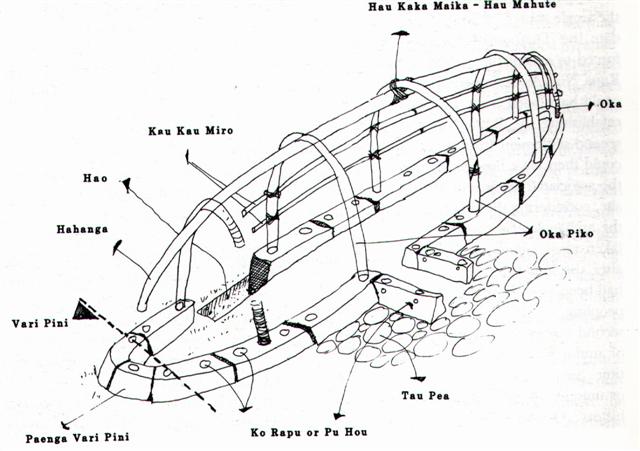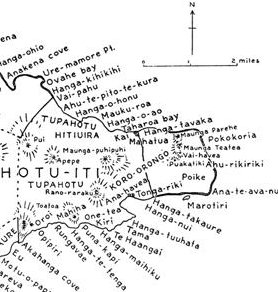2. In our timespace model formed as a hare
paega the ditch dividing the Poike peninsula from the rest of the
island could be represented by the dotted line:

The 12th hole counted from the entrance - beginning
at Te Pu Mahore (with 2 holes) and Te Poko Uri on the
right side, and continuing with Te Manavai and Te Kioe Uri
on the left side - could represent Tama (just inside the
vari pini dotted line).
But I prefer to count Te Pu Mahore as 1
station, because nothing in the kuhane journey indicates
anything else. Station number 11 ('one more' than 10) is Roto
Iri Are - like a tuft of seaweed - and it will then be represented by the hole
located just inside the vari pini line and Tama
will be the single hole in next stone. One Tea
will be the hole cut through by the dotted line, and after that the
vari pini season is over and the following station will be Hanga
Takaure:
|
Around
Rano Kau: |
|
Old Land |
Te Pu Mahore |
Te Poko Uri |
|
Sea |
|
New land |
Te Manavai |
Te
Kioe Uri |
|
Along the southern coast - 1st part: |
|
5 Te Piringa Aniva |
6 Te Pei |
7 Te Pou |
|
Along the southern coast - 2nd part: |
|
8 Hua Reva |
9 Akahanga |
10 Hatinga
Te Kohe |

|
The eastern corner -
1st part: |
|
11
Roto Iri Are |
12 Tama (*) |
13 One Tea (†) |
|
The eastern corner
- 2nd part: |
|
14 Hanga Takaure |
15 Poike |
16 Pua Katiki |
|
The eastern corner
- 3rd part: |
|
17 Maunga Teatea |
18
Mahatua |
|
19 Taharoa |
20 Hanga Hoonu |
The ridgepole (hahanga) has
been drawn without contact with the vari pini hole which I
guess represents Tama.
| Hahaga.
Ridge, summit, wall plate. Maroa hahaga, to measure
lands, to walk at a great pace. |
At the hole of Poike a contact with the
other side (Hua Reva) is established and the roof will
be supported from then on. I think it means Sun reaches maturity (he
is standing high in the sky) and that he is initiated into
the life of an adult. Counting 5 stations forward we maybe will reach
his end
station at Hanga Hoonu. The Gilbertese counted the
nights of Moon up to 20, but no longer.
I guess we should count with 1
hole for the hou ditch, because then Hanga Hoonu
will be represented by a hole which is cut in half by one of the
lines describing an Oka Piko. From the hole
of Hanga Takaure up to and including the hole of Hanga
Hoonu there would be 7 holes.
Of
central importance is the16th station Pua Katiki, which I
have located to the hao hole:






